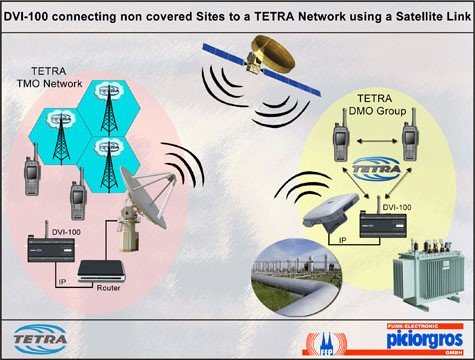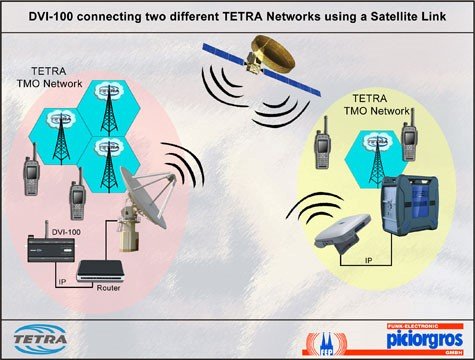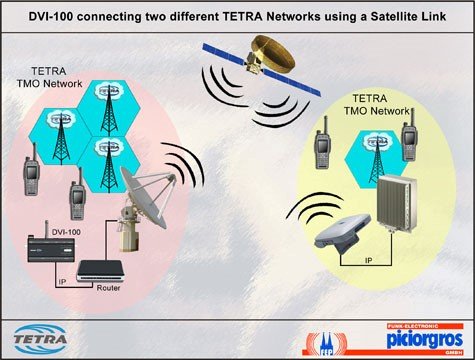DVI-100 Applications
1270 Views |
DVI-100 Applications
The DVI-100 (DVI=Digital Voice Interface) is a TETRA Inter System Interface to connect Talk Groups from different TETRA Infrastructures. To achieve this, two DVI’s are used, one is registered on each of the TETRA Networks, and they are connected together via IP. The important feature of this solution is that the digital ACVELP coded voice stream is neither converted to an analog signal nor re-coded into PCM or another digital code at any time. This ensures that the brilliant TETRA voice quality is retained.
In addition to the interconnection of talk groups from different TETRA Networks, a variety of other interesting Applications can easily be set up with the DVI-100 shown on the following pages:
Backup Link for TETRA Base Station that are operating in Fallback Mode
TETRA Base Stations are controlled – similar to GSM networks – by centralized or de-centralizes switches (SwMi = Switching and Management Infrastructure). Thereby each Base Station is linked by an E1 connection or an IP link, to a Controlling Device that manages the complete TETRA network. If the link between Base Station and SwMi gets lost, the Base Station will operate in a local mode (Fallback Mode) but the communication to the network is lost. A DVI-100 that is logged into that Base Station, offers an alternative link that can be used as a secondary connection to the main network or just to a control room.

Connecting non-covered areas to the TETRA main network using GSM
With the iPhone or iPad DVI-Client Software (developed from Piciorgros GmbH) and a DVI-100, one can connect from anywhere inside or even outside of the TETRA network to TETRA Talk Groups. Up to 10 iDevices (or PC Client(s)) can be connected to a single DVI-100 and like a regular hand portable it can be a member of a talk group. The iPhone cannot manage Talk Groups, but the iPad and PC client (when used in supervisor mode) can select and manage between 10 active groups.

DVI-100 MicroSPOT, a TETRA Network Extension for Maritime Applications
A variation of the DVI-100 working in DMO mode acts like a TETRA MicroSPOT and can cover several hundred meters or more, depending on antenna type and antenna height. Connected to a Satellite (successfully tested with Thuraya IP equipment) the TETRA MicroSPOT can link a vessel or a complete fleet to the main TETRA network. This gives a unique and instant communication option to ship owners, captain and crew.

DVI-100 MicroSPOT, connecting non covered sites to a TETRA network using a Thuraya Satellite Link
A variation of the DVI-100 working in DMO mode acts like a TETRA MicroSPOT and can cover several hundred meters or more, depending on antenna type and antenna height. Connected to a Satellite (successfully tested with Thuraya IP equipment) the TETRA MicroSPOT can link any “out of the TETRA coverage site” to the main TETRA network. This gives a unique and instant communication option to staff working on site in Gas and Oil, Water, Wastewater, Utility and many other applications.

DVI-100 MicroSPOT, connecting non-covered sites to a TETRA network using a Digital Subscriber Line
A variation of the DVI-100 working in DMO mode acts like a TETRA MicroSPOT and can cover several hundred meters or more, depending on antenna type and antenna height. Connected via a DSL Line the TETRA MicroSPOT can link any “out of the TETRA coverage site” to the main TETRA network. This gives a unique and instant communication option to staff working on site in Gas and Oil, Water, Wastewater, Utility and also other applications.

DVI-100 linked via Satellite to a remote Etelm TETRA infrastructure
Another solution for extending a TETRA network or covering “white spots” is to link the main network using a DVI-100 directly to another infrastructure, that uses the same (Open-PTX) protocol as the DVI. In this case a Satellite, GSM or DSL line can be used regarding on the users choice and depending on the costs.

DVI-100 linked via Satellite to a remote Damm TETRA infrastructure
Another solution for extending a TETRA network or covering “white spots” is to link the main network using a DVI-100 directly to another infrastructure, that uses the same (Open-PTX) protocol as the DVI. In this case a Satellite, GSM or DSL line can be used regarding on the users choice and depending on the costs.

